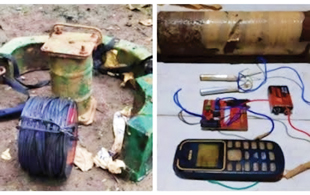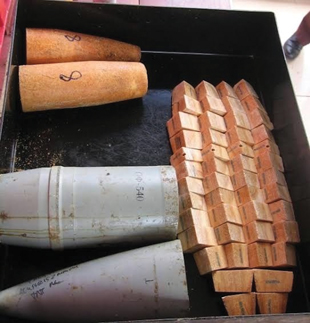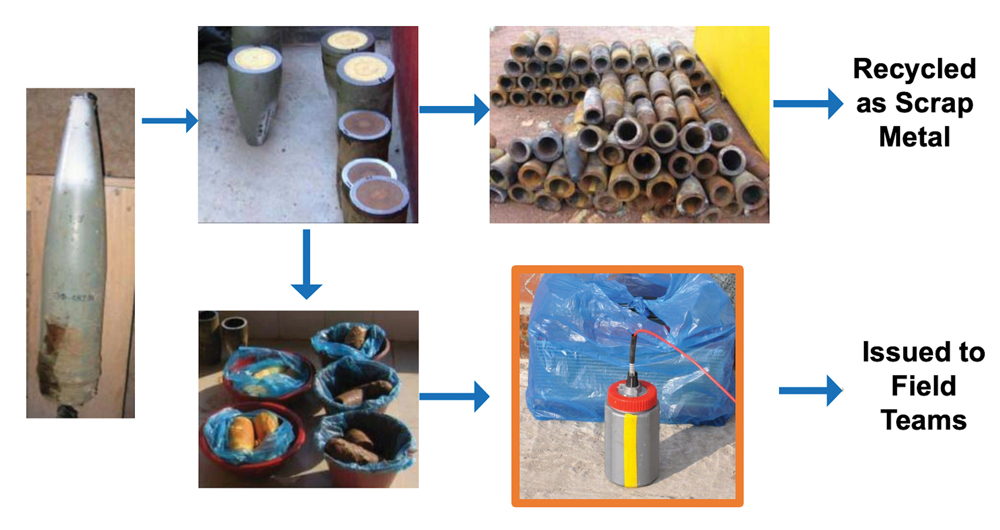Empowering Host Nation Counter-IED and Counter-Insurgency Efforts: Innovative Application of Ordnance Recycling
By Lynna Banach [ American Public University ], Commodore Roy Vincent T. Trinidad [ Armed Forces of the Philippines ], and Captain Julien B. Dolor [ Armed Forces of the Philippines ]
CISR JournalThis article is brought to you by the Center for International Stabilization and Recovery (CISR) from issue 27.3 of The Journal of Conventional Weapons Destruction available on the JMU Scholarly Commons and Issuu.com.
As the United States works to grow its defense partnership with the Philippines, the country continues to fight instability and insecurity amidst a lengthy battle against insurgent and terrorist groups.1,2,3 As the overlap between urban areas and conflict zones increases, and with violent groups’ use of improvised explosive devices (IEDs) against government forces, the danger to civilians escalates.4 This paper provides a deeper understanding of how the prevalence of unexploded ordnance (UXO) and the use of IEDs in the Philippines fuel the realities of insurgency and humanitarian danger in the country. Furthermore, using Golden West Humanitarian Foundation’s (Golden West) program in Cambodia as a framework, this paper examines how the innovative application of Golden West’s ordnance recycling technology in the Philippines would impact the host nation’s ability to counter the enduring challenges posed by insurgency groups use of UXO and IEDs. Employing Golden West’s technology in a way that uses deteriorating ordnance stockpiles, surplus ordnance, and explosive remnants of war (ERW) to produce water disruptors for use as a successful, efficient, and affordable method of handling explosive hazards offers a unique approach to supporting the Philippines in its counterinsurgency battle.
Introduction
In the Philippines, the conflict zones overlap with urban areas, meaning civilians are increasingly in danger as violent groups use IEDs against government forces.5 While explosive ordnance (EO), munitions and ammunition depot explosions, and other UXO-related events pose serious risks to the civilian population in the Philippines, insurgents and terrorists benefit from the acquisition of explosive material from aging, poorly maintained, and poorly secured ordnance stockpiles, which also wind up in conflict zones or surrounding areas.6,7
Golden West is a nonprofit organization based in the United States that works to create cutting-edge tools, programs, and methods to improve the effectiveness of the humanitarian mine action (HMA) community on a global scale.8 In Cambodia, Golden West successfully produces high-quality main charge explosives for use in HMA operations via its Explosive Harvesting Program (EHP).9 Using their program in Cambodia as a framework, the employing of explosives recycling technology in the Philippines would empower the host nation to decrease its aging and surplus UXO stockpiles and ERW in a sustainable way that saves lives while simultaneously decreasing the amount of explosives material available to insurgent groups, supporting host nation counter-IED efforts, and building defense partnerships.
Background and Problem Set
In the Philippines, UXO from the Second World War, Vietnam War, Indochina Wars, and the Cold War continues to pose a threat.10,11 In the decades following the end of these hostilities, there has been significant economic growth and population expansion into previously uninhabited areas, exposing UXO that pose a serious threat to safety and impede local economic development.12 Moreover, ordnance stockpile management is a concept that is critical to ordnance security, functionality, and safety. However, in practice, ordnance stockpile management efforts vary greatly globally, often based on knowledge of best practices and the availability of resources to implement such practices. In the Philippines, for example, the root causes of incidents of unplanned explosions at munitions sites between 1979 and 2013 included lack of surveillance leading to ammunition deterioration, inappropriate storage systems and infrastructure, and failure to consider external environmental influences and events.13 While the Philippines works to secure and liquidate old, expired, and unstable UXO stockpiles, the country is also battling violent insurgent and terrorist groups.

Figure 1. Terrorist group IED components recovered in Maguindanao Province, Philippines, after military operations pushed Bangsamoro Islamic Freedom Fighters from Maguindanao Province in November 2019. Courtesy of 6ID.
As the Philippines government contends with insurgent and terrorist group activity, non-state actors use IEDs as a main weapon in their battles against the government, endangering both government forces and civilians.14,15,16,17,18 IEDs can have a main charge made of military explosives, ordinary ammunition, or home-made explosives, and are employed in attacks that purposefully target government forces and the civilian population.19,20,21 Even if these explosive weapons target a specific population, the overlap of civilian populations with conflict zones means that the explosives often impact unintended and collateral targets in a wide area.22 Furthermore, the availability of unsecure and unstable ordnance for nefarious insurgent and terrorist use contributes to the prevalence of the intersection of civilian life with UXO and IEDs. Through a deeper understanding of the prevalence of UXO and the use of IEDs in the Philippines, how these dynamics fuel the realities of insurgency and humanitarian danger in the country become clearer. Although the Philippines government is working to manage aging ordnance stockpiles, counterinsurgency, and the use of IEDs, the danger these three issues pose to civilians remains.
Ordnance Recycling and Water Disruptors as a Solution
Through its EHP, Golden West employs its ordnance recycling technology across Cambodia. The initial goals of the program included providing a deployable, affordable method to defuse explosives from weapons like aircraft bombs, anti-tank mines, and artillery, and establishing a method to transform the recovered explosives into tools for demining and explosive ordnance disposal (EOD) teams.23 Over the last fifteen years, working closely with the Cambodian Ministry of Foreign Affairs (MoFA) and the Cambodian Mine Action Centre (CMAC), the program has exceeded these goals.24 In Cambodia, the EHP breaks down discovered ERW and surplus ammunition stores using a cutting and steaming process before using the components to generate small 100g and 300g donor charges for use by nongovernmental organizations (NGOs) in demining operations.25 Additionally, after the removal of the main charge and any remaining explosive residue, the program is able to recycle any scrap metal from ERW casings. Golden West now maintains its Applied Technology Training Center (ATTC) located in Kampong Chhnang, Cambodia, where the program supports the production of donor charges for humanitarian demining organizations in Cambodia and year-round EOD training and logistical support.26 In addition to having a proven framework to use as a model, an innovative program in the Philippines will have the advantage of building upon the development and progress made by the EHP in Cambodia.
Innovative Ordnance Recycling in the Philippines
While the explosives recycling program in Cambodia recycles ERW to create donor charges for use in demining operations, a parallel program in the Philippines would break down UXO and ERW, recycling the components into water disruptors. A simple tool commonly used by police forces and armies in counter-IED operations, water disruptors use water as a projectile to separate IED components rapidly and in such a way that inhibits the IED explosion from occurring.28 Water disruptors are sustainable and easily implemented and managed by host nations.
Benefits of Generating Water Disruptors for Counter-IED Use

Golden West’s EHP components and donor charges in Cambodia.27 Courtesy of Golden West Humanitarian Foundation.
Although water disruptors and their use as a counter-IED tool continue to evolve, the basic design and concept is rather simple. Water bottle disruptors typically consist of a plastic bottle filled with water and a tiny amount of high explosives that creates a non-aggressive charge.29 Upon detonating the explosives, the water is ejected at a high speed, separating the IED circuitry before the bridge wire in the detonator has a chance to react, attempting to defuse rather than detonate the device.30,31,32 The semi-remote use of water disruptors involves the operator manually positioning the disruptors close to IEDs without disturbing them, with the main purpose of the IED disrupter being to neutralize IEDs as part of a render safe procedure.33,34 These disruptors are ideal for deployment in situations where it is possible to specifically target the IED power source, and they offer many advantages, including a secure, reliable, effective, and consistent means of defusing IEDs and reducing contact with the IED and time inside the explosives threat zone.35,36 Furthermore, water disruptors may be reusable if necessary, offering unique value for the price-point in addition to not requiring the same types of permits required for the acquisition, transportation, and storage of high explosives.37 Ultimately, in the Philippines, using water disruptors to counter IEDs is an approach that the host nation can use as part of a greater counterinsurgency strategy.
Choosing to create water disruptors from recycled ordnance in the Philippines comes with multiple advantages. Given the makeup of water disruptors and how they disarm IEDs, the resulting small, non-aggressive charges are generally not usable for nefarious purposes and unable to hurt people. These safety characteristics of water disruptors are especially pertinent to ensuring that the products of the ordnance recycling program are not able to negatively contribute to the situational dynamics in the country. Additionally, any water disruptors created via an ordnance recycling program using Golden West’s ordnance cutting technology will be officially serialized, similar to the donor charges created via the ordnance recycling program in Cambodia and distributed as IED disruption tools.
A final important aspect of the program is the low cost of creating the disruptors. Each disruptor will consist of a recycled charge contained in a water bottle-like container with a straw, resulting in a locally manufactured and maintained product costing less than USD25. This cost-point is important with respect to long-term program affordability. Overall, using ordnance recycling technology to create water disruptors is a safe, affordable, and sustainable means to generate counter-IED tools for use in the Philippines.

Figure 2. Ordnance recycling and water disruptors as a solution for the Philippines, which conceptually illustrates how an EHP program would break down UXO and ERW into recyclable scrap metal and components used to generate water disruptors—a simple tool commonly used by police forces and armies in counter-IED operations.38 Courtesy of Golden West and Eodpromartin,39 Bottler,40 CC BY-SA 3.0.41
Strategic Benefits of Ordnance Recycling and Water Disruptors as a Solution
Aside from the various tactical benefits of implementing an ordnance-recycling program, there are several strategic-level benefits as well. As with the explosives recycling program in Cambodia, the primary objective of implementing the proposed program in the Philippines is to save lives. With “at least ninety percent of the casualties caused by the use of explosive weapons in populated areas likely to be civilians,” the scope of the problem is massive.42 Aside from the trauma and fear of IED use in civilian areas, in more rural areas, land contamination from explosive war relics puts residents at risk for generations and frequently prevents local inhabitants from returning or using the land for livelihood purposes.43,44 Through building strong and cooperative relationships with the Royal Cambodian Armed Forces (RCAF) who now turn over their surplus ammunition for processing, the EHP in Cambodia has identified a reliable internal source of disposal explosives to support long-term clearance operations, lowered public safety hazards associated with ammunition storage, and diminished environmental harm brought on by bulk ordnance destruction.45 Though slightly modified for the counter-IED and counterinsurgency mission, a program in the Philippines would mirror these achievements. By reducing the local and regional risks and hazards created by deteriorating and unsecured conventional ordnance, decreasing the amount of ordnance available for IED production, and increasing the tools available to counter-IED use in the country, the ordnance recycling program will help to save lives in the Philippines.
Another projected benefit of the program is recycling of the steel typically used to encase UXO. While the steel casing of UXO may be corroded due to exposure to harsh conditions, most thick steel casings will only experience superficial corrosion with a majority of the casing remaining intact.46 Steel and copper are potential byproducts of the old ordnance recycling process, and after treating the empty munitions casing to ensure elimination of any residual explosives residue, Golden West’s EHP in Cambodia has reclaimed tons of metal.47,48 The steel byproduct of the ordnance recycling process is a substantial benefit given that the Philippines is “the world’s 17th-largest steel importer,” and the demand for steel in the Philippines continues to grow.49,50 The recycling of steel byproducts can generate revenue for use in continuing to fund the program via paying for water disruptor materials or program training, increasing the sustainability and benefits of the program for the host country.51
Final overarching benefits of the program are the building and strengthening of relationships with the host nation and counter-IED capacity building within the Philippines. The proposed ordnance recycling program represents a lower cost, sustainable way to support defense and security partnerships with limited resources, while helping to fight insurgency in the Philippines.
Conclusion
Employing Golden West’s technology in an innovative way that uses deteriorating ordnance stockpiles, surplus ordnance, and ERW to produce water disruptors for use in handling explosive hazards offers a unique approach to supporting the Philippines in its counterinsurgency battle. Not only will the proposed solution impact the host nation’s ability to counter the enduring challenges posed by explosive hazards and insurgency groups, it will also save lives and strengthen international partnerships. Ultimately, when considering the implementation of the EHP technology to sustainably produce a safe counter-IED tool for host nation use, Golden West believes the benefits greatly outweigh the initial investment and has a signed partnership with the Philippine Navy NAVSOCOM to pursue the program. Dependent on funding, the program will commence in 2024.
Lynna Banach is a Doctoral student at American Public University. The views and analysis expressed in this article are those of the author, purely expressed for academic reasons, and in no way represent an official position of American Public University or any federal agency.
Lynna Banach is a professional in the analysis field and is currently pursuing a Doctorate of Strategic Intelligence at American Public University. She has an extensive background in force protection and holds a Bachelor of Science degree in Psychology and a Master of Science degree in Terrorism and Counterterrorism Studies. In expanding her research experience, Banach has been working with Golden West Humanitarian Foundation and international partners to explore innovative applications of ordnance recycling technology.
 Commodore Roy Vincent T. Trinidad PN is a career naval officer who has specialized in surface warfare, special warfare, and naval intelligence. He is a member of the PMA “Sambisig” class of 1991. He has spent more than half of his thirty-two years commissioned service in operations as a Navy SEAL, assigned aboard commissioned vessels of the Navy or with intelligence units of the AFP, mostly in Mindanao and the West Philippine Sea. He has extensive experience working with foreign armed services, most notably as the Incident Commander at Tacloban Airport after Typhoon Yolanda (international code name: Haiyan). As the ICS Commander of the affected area of the super typhoon, he was on the first plane that landed in the city and organized naval units, joint and combined forces, and the domestic and international NGOs/INGOs. He has a master’s degree in public administration specializing in development and security and is completing his doctoral dissertation in peace and security administration. He has numerous combat and administrative awards at the tactical, operational, and strategic levels. Commodore Trinidad often presents internationally and is a leader in counter-IED protocols.
Commodore Roy Vincent T. Trinidad PN is a career naval officer who has specialized in surface warfare, special warfare, and naval intelligence. He is a member of the PMA “Sambisig” class of 1991. He has spent more than half of his thirty-two years commissioned service in operations as a Navy SEAL, assigned aboard commissioned vessels of the Navy or with intelligence units of the AFP, mostly in Mindanao and the West Philippine Sea. He has extensive experience working with foreign armed services, most notably as the Incident Commander at Tacloban Airport after Typhoon Yolanda (international code name: Haiyan). As the ICS Commander of the affected area of the super typhoon, he was on the first plane that landed in the city and organized naval units, joint and combined forces, and the domestic and international NGOs/INGOs. He has a master’s degree in public administration specializing in development and security and is completing his doctoral dissertation in peace and security administration. He has numerous combat and administrative awards at the tactical, operational, and strategic levels. Commodore Trinidad often presents internationally and is a leader in counter-IED protocols.
 Philippine Navy Captain Julien B. Dolor holds a Bachelor of Science in Management from the Philippine Military Academy and a master’s degree in public management and major in development and security from the Development Academy of the Philippines. His master’s thesis focused on “The Philippine Navy Disposal Management of Explosive Remnants of War, Unserviceable Ammunitions, and Improvised Explosive Device.” In his twenty-eight years of experience, Captain Dolor has worked in naval special warfare/special operations, intelligence, and protective security. He is currently the Chief of the Research Division at the Office of the Deputy Chief of Staff for Operations, Armed Forces of the Philippines (AFP), while pursuing a Strategic Intelligence Course in one of the AFP’s Special Intelligence School.
Philippine Navy Captain Julien B. Dolor holds a Bachelor of Science in Management from the Philippine Military Academy and a master’s degree in public management and major in development and security from the Development Academy of the Philippines. His master’s thesis focused on “The Philippine Navy Disposal Management of Explosive Remnants of War, Unserviceable Ammunitions, and Improvised Explosive Device.” In his twenty-eight years of experience, Captain Dolor has worked in naval special warfare/special operations, intelligence, and protective security. He is currently the Chief of the Research Division at the Office of the Deputy Chief of Staff for Operations, Armed Forces of the Philippines (AFP), while pursuing a Strategic Intelligence Course in one of the AFP’s Special Intelligence School.
| Stay updated | |||

